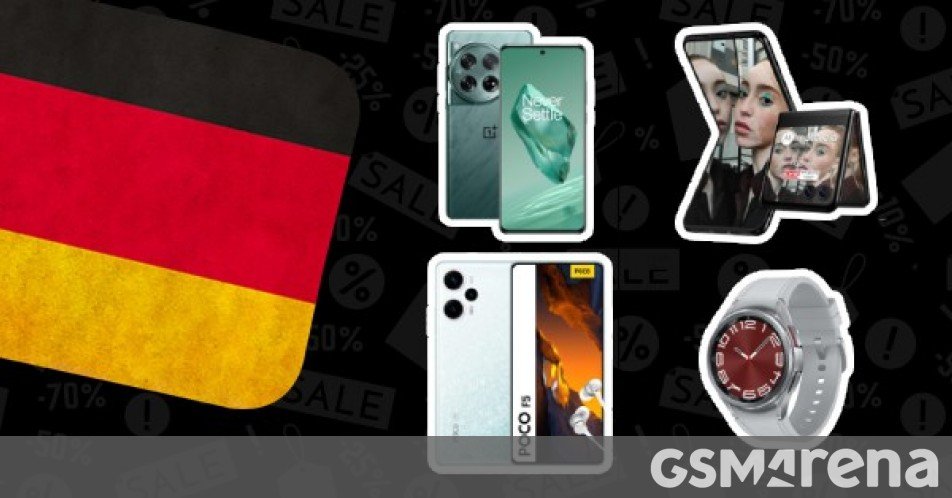Amazon’s Spring sale brings great discounts on smartphones old and new. We picked out a few flagships, but some of the mid-rangers offer value for money that is hard beat.
The OnePlus 12 flexes its Snapdragon 8 Gen 3 muscles on the 6.82” 120Hz LTPO AMOLED display with QHD+ resolution. The chip also handles processing for the Hasselblad-branded cameras – 50MP main (1/1.43”, OIS), 64MP 3x tele and 48MP ultra wide (114°). The phone is super fast to charge its large 5,400mAh battery at 100W wired and 50W wirelessly.
Is it finally time to jump to a foldable phone? The Motorola Razr 40 Ultra is a whopping 39% off. To be fair, this may be because a new model is coming soon. That Snapdragon 8+ Gen 1 is a bit old, but still plenty fast, and you get a wonderful 6.9” 165Hz LTPO display that fits in a compact package. When closed, you can use the 3.6” 144Hz cover display.
The Samsung Galaxy Z Flip5 brings the newer Snapdragon 8 Gen 2 (and it’s the boosted “for Galaxy” variant), but it costs €120 more and it itself is due for a replacement soon. Also, the 6.7” 120Hz display inside is not an LTPO panel, but at least this generation got a usable 3.4” cover display.
Remember the Z Flip4? Its cover display was as small as the one on the Motorola Razr 40. To be fair, the vanilla Razr is only €600, but dropping down to a Snapdragon 7 Gen 1 may not sound appealing to some – you may want to pay the €130 premium and get the Ultra.
The Snapdragon 7+ Gen 2 is an odd chip – it’s significantly more powerful than the 7 Gen 3 that was supposed to replace it. And with the Poco F5, you can have it for only €320 (this is with 12GB of RAM and 256GB storage to boot).
The Poco F5 Pro is an interesting offer too – Snapdragon 8+ Gen 1 for €400 (this too with 12/256GB memory). The Pro model also makes the 6.67” 12-bit AMOLED display into a QHD+ panel, up from FHD+ resolution (both 120Hz). The cameras are the same (64+8MP), the battery on the Pro is 160mAh larger at 5,160mAh.
Another vanilla/pro pairing comes with the Poco X6 Pro. This one has a Dimensity 8300 Ultra chipset and the 6.67” 12-bit 120Hz display splits the difference between FHD+ and QHD+. This costs €310 for the 8/256GB model, so you may gravitate towards the Poco F5.
The vanilla Poco X6 uses the Snapdragon 7s Gen 2, which is weaker than both the 7+ Gen 2 and 7 Gen 3. This one also uses slower storage, UFS 2.2 vs. 4.0. It is cheaper at €260, whether the savings are worth it is up to you.
The Redmi Note 13 Pro cost €340 for the same 7s Gen 2 chip (also paired with UFS 2.2 storage). To be fair, a lot of the budget was spent on the 200MP main camera.
You could get the Redmi Note 13 Pro+, which uses the better Dimensity 7200 Ultra instead (and UFS 3.1 storage), but if you’re going up to €400, you may as well pick up the Poco F5 Pro.
Let’s look at some lower prices. The Samsung Galaxy A25 won’t win any awards for speed with its Exynos 1280, but it’s a decent chip. And you get a microSD slot, 3.5mm headphone jack along with an impressive for the price range 4 OS updates and 5 years of security patches. Not bad for €250, though we could have done without the notch in the 6.5” FHD+ 120Hz OLED display.
We know it’s old, but the Motorola Edge 30 Neo offers a 6.28” 120Hz OLED display and 5G connectivity (even if it comes from an ancient Snapdragon 695), plus a 64MP main camera with OIS and 13MP ultra wide and both 68W wired and 5W wireless charging. This is all for €210 with a generous 8GB of RAM and 256GB storage.
The Moto Edge 40 Neo is newer (September last year) and it upgrades to a Dimensity 7030, a 50MP main camera with a larger 1/1.5” sensor (1.0µm pixels vs. 0.7µm, still with OIS) and 4K video recording. The screen grows to 6.55” (120Hz FHD+ OLED), but the battery loses its basic wireless charging (many people overnight charge, so 5W is good enough).
Finally, some smartwatches. The Samsung Galaxy Watch6 and Galaxy Watch6 Classic are around €100 apart in both their small and large sizes. The Classic is a bit larger due to the unique rotating bezel.
If you want a large watch for less, check out the Galaxy Watch5 Pro. It’s older and misses out on the rotating bezel, but you can have the LTE model for less than the Bluetooth Watch6 Classic. Note that the Pro has a titanium frame instead of stainless steel, making it lighter than the Classic (46.5g vs. 59g) despite being roughly the same size. And despite having a larger battery too, 590mAh vs. 425mAh.
We may get a commission from qualifying sales.

















